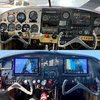PHILIP GUZIEC
Filing Flight Plan
- Joined
- Nov 21, 2022
- Messages
- 11
- Display Name
Display name:
TurboM20E
Hi all.
Unfortunately, the GX60 In my mooney can no longer be updated and I'm being forced into an upgrade cycle. I'm trying to contain the cost of the whole thing But of course the avionics chops want me to rip everything out and sell every upgrade So, some tactical questions.
My current setup is a century attitude indicator and HSI that drive a century 2000 auto pilot. The input to those is a switch and a nunciator between the GX60 and A king nav with glideslope..
What I'd like to do is ditch my tailbeacon and put in a garmin 375 in the same place is the GX60 And replace my DME with an old king com that I have on the shelf. One shop I talk to tells me that I can't use the existing annunciator switch for the output of the 375 and the nav to the hsi and autopilot.
My 1st question is whether it is true that I can't use the existing annunciator switch. It seems like it would be a paperwork issue rather than an actual functional issue if the existing switch can't be used.
If in fact I can't use the existing switch I would wire the 375 directly into the HSI and the auto pilot. I have one localizer indicator without glideslope in the panel and I have a king localizer indicator with a glidelope on the shelf. I'm pretty familiar with automotive stuff but I'm not familiar with how things are done on airplanes and what's legal. Does anyone know if the king indicator connectors typically are the same between the units with or without glideslope so that wires and pins can be slipped in and added?
Another general question. I see units of different types ibeing sold with trays with wire pigtails. Is it legal to spilce wires in avionics? Is this typically done with a connector or solder and heat shrink?
Thanks for any advice!
Unfortunately, the GX60 In my mooney can no longer be updated and I'm being forced into an upgrade cycle. I'm trying to contain the cost of the whole thing But of course the avionics chops want me to rip everything out and sell every upgrade So, some tactical questions.
My current setup is a century attitude indicator and HSI that drive a century 2000 auto pilot. The input to those is a switch and a nunciator between the GX60 and A king nav with glideslope..
What I'd like to do is ditch my tailbeacon and put in a garmin 375 in the same place is the GX60 And replace my DME with an old king com that I have on the shelf. One shop I talk to tells me that I can't use the existing annunciator switch for the output of the 375 and the nav to the hsi and autopilot.
My 1st question is whether it is true that I can't use the existing annunciator switch. It seems like it would be a paperwork issue rather than an actual functional issue if the existing switch can't be used.
If in fact I can't use the existing switch I would wire the 375 directly into the HSI and the auto pilot. I have one localizer indicator without glideslope in the panel and I have a king localizer indicator with a glidelope on the shelf. I'm pretty familiar with automotive stuff but I'm not familiar with how things are done on airplanes and what's legal. Does anyone know if the king indicator connectors typically are the same between the units with or without glideslope so that wires and pins can be slipped in and added?
Another general question. I see units of different types ibeing sold with trays with wire pigtails. Is it legal to spilce wires in avionics? Is this typically done with a connector or solder and heat shrink?
Thanks for any advice!
Last edited:


